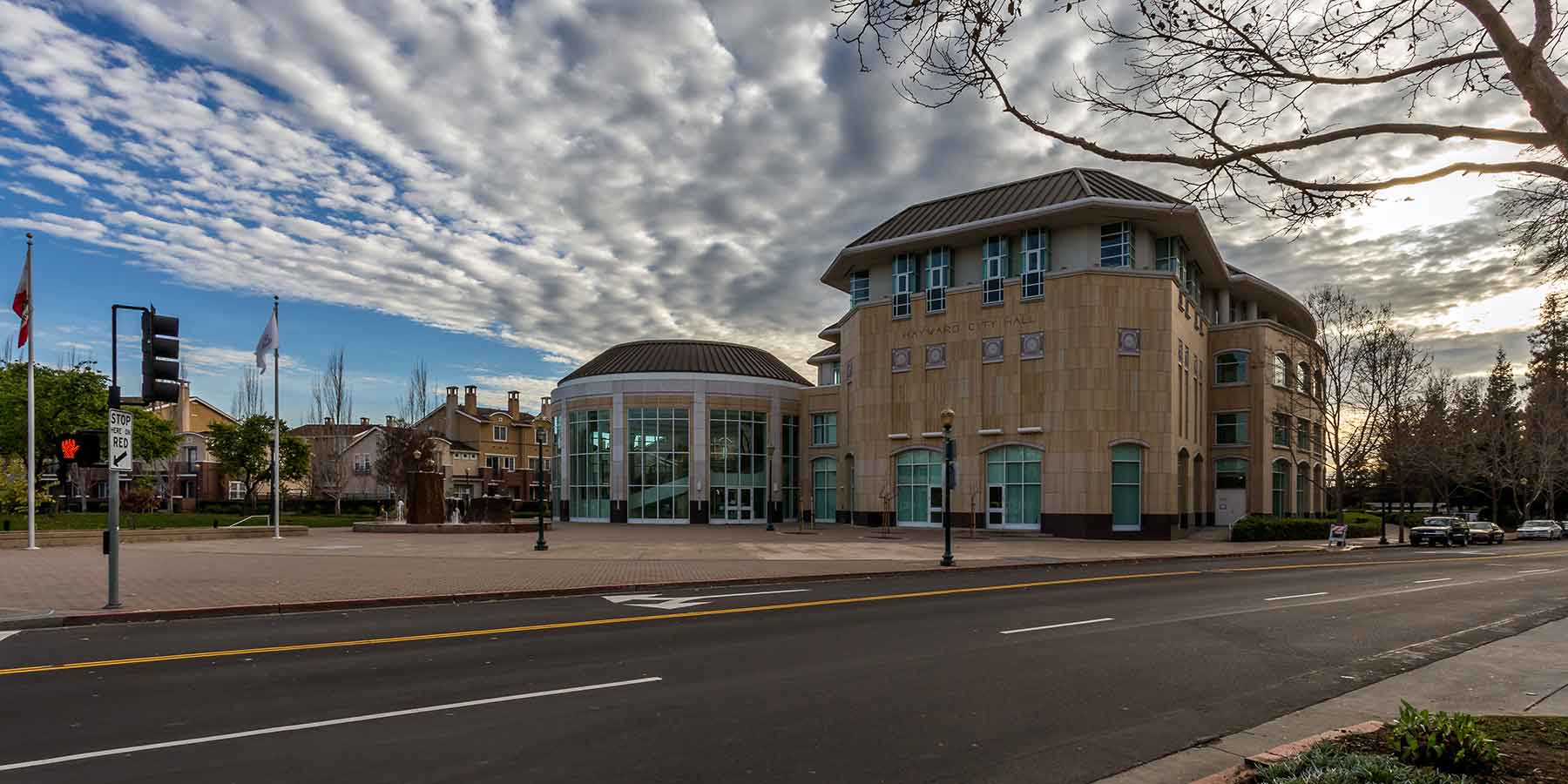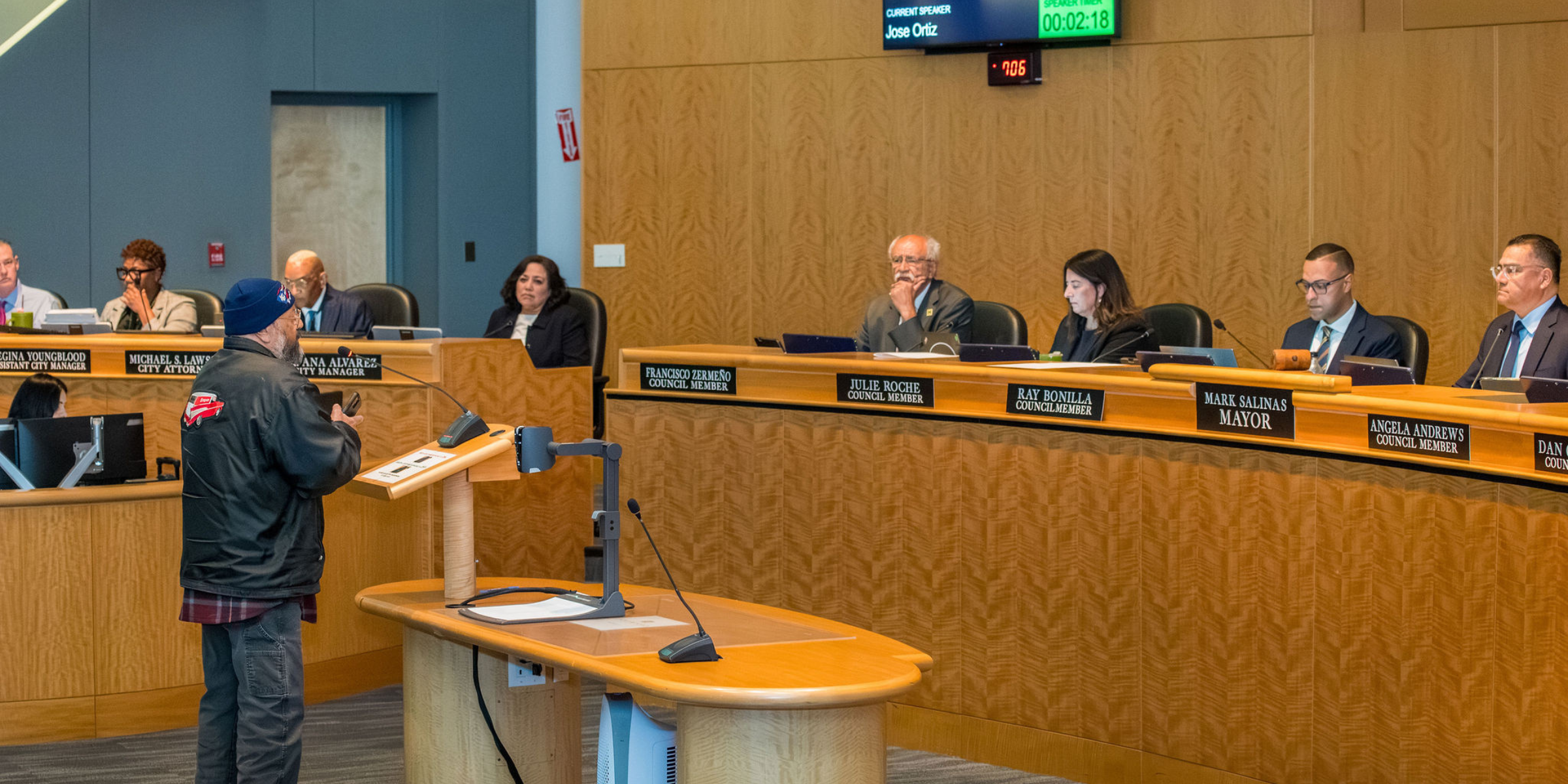Transportation Sector Measures
Transportation accounts for the largest portion of GHG emissions in Hayward.
The City of Hayward strives to promote transportation options that provide a robust set of health, mobility, and livability benefits for all community members. The City is committed to developing a thriving transportation network to encourage residents to make more sustainable and healthy choices.
Reducing Vehicle Miles Travelled
These transportation measures (T) prioritize reducing vehicle miles travelled (VMT) first, by improving active and public transportation, then shifting the remaining VMT to electric vehicles. While in theory, 100 percent electrification of all vehicles in Hayward could achieve zero-emissions in the transportation sector without reducing VMT, the City recognizes that cars and roadways carry huge amounts of embodied emissions not accounted for in the inventory, over which the City has little control. Beyond decreasing GHG emissions, there are other benefits associated with reducing VMT. These include alleviating traffic congestion, requiring less space for roads and parking, promoting local economic revitalization, and enhancing overall quality of life.
In line with the Hayward 2020 Bicycle and Pedestrian Master Plan, the City will increase active transportation mode share to 15 percent by 2030 and 20 percent by 2045 (Measure T-1). The City will implement public and share transit programs to increase mode shift to public and shared transit mode to 15 percent by 2030 and 30 percent by 2045. While Measures T-1 and T-2 can be effective in changing community choices around transportation, the impacts of incentive-based policies increase when coupled with disincentives for less favorable choices, such as making it less convenient to drive a gasoline-fueled single passenger vehicle. Through Measure T-3, the City will develop disincentives for driving single passenger vehicles to support the bicycle/pedestrian and public transit mode share goals.
Electrification
While the City cannot require its residents or businesses to buy Zero-Emission Vehicles (ZEVs), Measures T-4 and T-5 will ensure the infrastructure and incentives are present in the City to begin to remove present barriers to passenger and commercial ZEV adoption. In line with this, the City will increase municipal passenger ZEV adoption to align with the State of California’s ZEV goals. Measure T-6 establishes a goal of decarbonizing 15 percent of off-road equipment by 2030 and 80 percent by 2045 to further contribute to the City’s overall GHG emissions reductions.
Measures and Actions Detail
Measure T-1: Increase active transportation mode share to 15% by 2030 and to 20% by 2045.
Actions, co-benefits, City costs, community costs, and specific quantitative GHG emissions reductions associated with implementation of Measure T-1 are included in Table 17.
Table 17: Measure T-1 Actions
ACTION ID | ACTION DESCRIPTION |
|---|---|
| T 1.1 | Amend the Off-Street Parking Regulation of Municipal Code to incorporate smart growth principles and to incentivize walking, biking, and public transit. 1. Create a single “blended” parking requirement for commercial uses to facilitate future changes of use (i.e., changing a retail store to a restaurant). 2. Provide requirements or incentives for bicycle parking. 3. Allow on-street parking along the property’s frontage to count towards satisfying a portion of the property’s off-street parking requirements. 4. Create parking preferences or incentives for residents who rideshare or use low- or zero-emissions vehicles. 5. Allow property owners to develop and implement parking demand management plans that consider ways to reduce the need for off-street parking by using shared parking arrangements, valet parking services, paid parking, and other appropriate techniques. 6. Establish design standards or retrofit standards for Complete Streets. 7. Promote multi-modal use. Key Pillar: Structural Change |
| T 1.2 | In support of the General Plan and City land-use policies, maximize infill development, increase land-use and transit efficiencies to support the regional Sustainable Communities Strategy29 and promote a jobs- housing match. In addition, work with developers to prioritize infill development projects and transit- oriented development zones. |
| T 1.3 | Based on the completed Complete Streets Assessment (existing Mobility program 6), the Complete Streets Inventory Baseline, and the 2020 Bicycle and Pedestrian Master Plan, develop a priority list of complete streets improvements such as retrofits, design standards, and green infrastructure that would accommodate walking, biking, transit use and carpooling. This effort should include a schedule for implementation, prioritization of improvements, identification of whether improvement will aid in walking, biking or transit access, and the plan should ensure equitable roll-out to low-income communities. Key Pillar: Structural Change |
| T 1.4 | Adopt and implement a micro-mobility policy that promotes ownership of micro-mobility devices, especially among lower income community members. Promote equitable access to charging facilities for electric micro-mobility devices. Key Pillar: Structural Change |
| T 1.5 | Continue to implement 2020 Bicycle and Pedestrian Master Plan goals of developing 153 new bicycle facilities and 32 miles of multi-use paths for pedestrians and cyclists. Key Pillar: Structural Change |
| T 1.6 | Evaluate and, if necessary, update the City's Zoning Code, Transportation Demand Management Plan (or Administrative Rule 2.26), and California Green Building Code to reflect current transportation demand management opportunities and to ensure the City requires sufficient bicycle parking for new commercial development and retrofits. Key Pillar: Structural Change |
| T 1.7 | Update and conduct Underused Rights-of-Way Study such that a community/business survey and evaluation is completed to understand community perspective on potential barriers to conversions and identify barrier solutions. Based on findings, convert recommended amount miles of under used roadways thoroughfare to active transportation corridors to create a connected environment City (i.e., downtown areas). As part of the program, launch a public campaign to gain public and business support to ensure success of such efforts. Consider having pilot programs (i.e., shutting down street lanes for specific events/periods of time) to demonstrate the advantages of proposed improvements. Key Pillar: Structural Change/Feasibility Study |
| T 1.8 | Identify streets for permanent through traffic closures to promote walking, biking, and other forms of active transportation. Key Pillar: Structural Change |
| T 1.9 | Identify areas of the City to remove parking and/or additional traffic lanes to prioritize outdoor seating and make permanent outdoor dining established during Covid 19. Key Pillar: Structural Change |
| T 1.10 | Prioritize active transportation and mobility projects in historically under-invested neighborhoods. Key Pillar: Equity |
| T 1.11 | Partner with schools, employers, transit agencies, Hayward Area Recreation and Park District (HARD), and community groups to teach bicycle and pedestrian safety in schools and workplaces and to educate residents and businesses about the health and environmental benefits of walking, bicycling, and using public transit. Key Pillar: Partnership/Education |
| T 1.12 | Partner with community organizations and local bike shops to provide rebates for low-income community members to purchase bicycles, helmets, pumps, e-bikes, e-scooters, and other related equipment. Work with community partners to provide incentives to promote bicycle, e-bike and e-scooter ownership. Key Pillar: Partnership |
| T 1.13 | Partner with community groups to obtain funding through the California Air Resources Board Car Sharing and Mobility Options program for a pilot bike-share program in low-income communities and to connect low-income communities with the E-Bike Purchase Incentive Program through CalBike. Key Pillar: Equity/Funding |
| T 1.14 | Ensure there is equitable access to safe bicycle and pedestrian infrastructure in all areas of the city. Prioritize the development of pedestrian and bicycle infrastructure in low-income communities where there is currently no or limited pedestrian and bicycle infrastructure. Key Pillar: Equity |
| T 1.15 | Based on the identified barriers to completing the Complete Streets Evaluation including limited staff and fiscal resources, develop strategies to reduce or eliminate barriers, such as identifying staff to assign the Complete Streets Evaluation to. Key Pillar: Feasibility Studies |
| T 1.16 | Devote staff time to managing, tracking and applying for grant funding to complete projects that would improve active transportation or mobility in the community. Key Pillar: Funding |
| Total GHG Emissions Reduction from Measure: 2030: 6,485 MT CO2e, 2045: 8,755 MT CO2e | |
| City Cost: High | |
| Community Cost: Low | |
| Co-Benefits: Improved Public Health & Safety, Sustainable Land Use Planning, Environmental Quality & Ecosystem | |
Measure T-2: Implement public and shared transit programs to increase mode shift to public and shared transit mode to 15% by 2030 and 30% by 2045.
Actions, co-benefits, City costs, community costs, and specific quantitative GHG emissions reductions associated with implementation of Measure T-2 are included in Table 18.
Table 17: Measure T-1 Actions
ACTION ID | ACTION DESCRIPTION |
|---|---|
| T 2.1 | Continue to promote infill development and/or new development that is compact, mixed use, pedestrian friendly, and transit oriented. Key Pillar: Structural Change |
| T 2.2 | Adopt a policy or code into the Municipal code that establishes specific standards for new development of public space to be transit accessible and multi-functional by co-locating public facilities. Key Pillar: Structural Change |
| T 2.3 | Consistent with the Downtown Parking Management Plan and Downtown Specific Plan, adopt parking requirements into the Municipal code that are appropriate for a mixed-use, walkable, and transit- oriented district. Evaluate opportunities in the Downtown area to designate streets for transit only. Key Pillar: Structural Change |
| T 2.4 | Develop and adopt an ordinance requiring new multi-family development projects to install a car share or provide e-bikes/e-scooters to each new tenant. Key Pillar: Structural Change |
| T 2.5 | Evaluate and prioritize transit stops needing renovations that do not meet the adopted Pedestrian Design Standard for Transit Stop. Upgrade transit stops such that they include bicycle parking and shade trees or structures and are designed to promote use. Key Pillar: Structural Change |
| T 2.6 | Consistent with the intention of Senate Bill 10, allow developers to build housing without off-street parking if they’re close to frequent transit service. Key Pillar: Structural Change |
| T 2.7 | Through the adoption of an ordinance or incorporation into large commercial building codes, require all employers to develop a Transportation Demand Management (TDM) Plan. TDM plans should include money-based incentives for employees to bike, walk, carpool, or take the bus to work. In alignment with BAAQMD requirement, large employers (more than 50 employees) shall subsidize biking, walking, or bus travel. Key Pillar: Funding/Structural Change |
| T 2.8 | Expand the Student Transit Pass Program (STPP), which provides free youth clipper cards with unlimited bus rides to middle and high schools students, to provide free AC transit to college students and low- income community members. Key Pillar: Partnership/Equity |
| T 2.9 | Collaborate and engage with AC Transit to understand how they are addressing the Innovative Clean Transit Rule and their plan to electrify their bus fleet. Key Pillar: Partnership |
| T 2.10 | Dedicate staff time or create a staff position to pursue funding opportunities to implement planned City transit/TDM projects and programs and to support AC Transit in obtaining grant funding for region-wide service expansion. Key Pillar: Funding |
| T 2.11 | Conduct local transportation surveys to better understand the community’s needs and motivation for traveling by car versus other alternatives such as AC Transit or BART. Use survey results to inform policy development and education/outreach campaigns that are transit focused. Consistent with the previous CAP policy M-3 (Survey Transportation and Transit Gaps and Barriers) Key Pillar: Feasibility Study |
| T 2.12 | Assess the feasibility and GHG reduction impact of banning cars in high-traffic zone(s) or on individual roads in the City where other transit options are available by implementing a congestion charge that applies to passenger cars and car-sharing services like Uber and Lyft with exceptions for handicap drivers and residents of those areas. Key Pillar: Feasibility Study |
| T 2.13 | Partner with AC Transit to conduct a study to determine transit priority corridors and prioritize infrastructure improvements in existing neighborhoods that enable people to better access and use public transit. Key Pillar: Feasibility Studies/ Partnerships |
| Total GHG Emissions Reduction from Measure: 2030: 7,585 MT CO2e, 2045: 25,092MT CO2e | |
| City Cost: High | |
| Community Cost: Low | |
| Co-Benefits: Improved Public Health & Safety, Sustainable Land Use Planning, Jobs Development | |
Measure T-3: Develop disincentives for driving single passenger vehicles to support the bicycle/pedestrian and public transit mode share goals of Measures T-1 and T-2.
Actions, co-benefits, City costs, community costs, and specific quantitative GHG emissions reductions associated with implementation of Measure T-3 are included in Table 19.
Table 19: Measure T-3 Actions
ACTION ID | ACTION DESCRIPTION |
|---|---|
| T 3.1 | Develop and adopt a Citywide Transportation Demand Management (TDM) Plan including strategies to reduce peak-hour traffic, such as staggered work hours, flexible schedule options, and telecommuting from home offices. Include updated policy incentives or disincentive options to achieve reductions in peak-hour traffic, reduce traffic congestions and promotes alternative transportation (biking, walking, and use of transit) Key Pillar: Structural Change |
| T 3.2 | Continue to require new development adopt transportation demand management strategies to reduce use of single occupancy vehicles and encourage the use of alternative modes of travel. Update development requirements, ordinances, and/or building codes requiring TDM as part of new developments as part of enforcement. Key Pillar: Structural Change |
| T 3.3 | Develop consistent standards for parking minimums and maximums across the city. Reduce parking minimums and parking maximums citywide, as improved active and public transit infrastructure becomes more available. Additionally, price all public parking spaces for all areas of the city based on available transportation options, travel demand, and land use. Key Pillar: Structural Change |
| T 3.4 | Evaluate parking pricing structures that would best work with the City of Hayward. Based on evaluation, implement dynamic parking pricing in downtown parking areas and earmark parking revenues to implement other active transportation and transit projects. Key Pillar: Structural Change |
| T 3.5 | Conduct an analysis of the potential community impacts and benefits of implementing disincentive-based policies for driving single passenger vehicles, including a congestion charge program, limiting parking options, increased local taxes (income tax, gasoline tax, or car registration tax), and Transportation Network Company (TNC) user taxes. Key Pillar: Feasibility Study |
| T 3.6 | Conduct engagement efforts for the general public and target low-income communities of color during analysis of the disincentive-based transportation policies to understand the community's potential concerns. Key Pillar: Equity |
| T 3.7 | Define equity metrics for implementation of disincentives based on feedback from local low-income communities of color and structure the disincentive programs to meet these metrics. Key Pillar: Equity |
| T 3.8 | Fund active and public transit programs through a local gasoline tax and/or through paid parking fees. Key Pillar: Funding |
| T 3.9 | Implement a Transportation Network Company (TNC) user tax which would put a small fee on the use of Uber and Lyft and generate funds to pay for transit and mobility infrastructure. Key Pillar: Funding |
| T 3.10 | Implement a gasoline/diesel car registration tax starting in 2028 with exemption criteria established for low-income residents. Key Pillar: Funding/ Equity |
| T 3.11 | Increase Broadband Internet Access. Add a program to encourage more working from home and reduce the need to travel for work. Key Pillar: Structural Change |
| Total GHG Emissions Reduction from Measure: Supportive Measures & Actions | |
| City Cost: Low | |
| Community Cost: Moderate | |
| Co-Benefits: Improved Public Health & Safety, Sustainable Land Use Planning | |
Measure T-4: Increase passenger zero-emission vehicle (ZEV) adoption to 15% by 2030 and 50% by 2045.
Actions, co-benefits, City costs, community costs, and specific quantitative GHG emissions reductions associated with implementation of Measure T-4 are included in Table 20.
Table 20: Measure T-4 Actions
ACTION ID | ACTION DESCRIPTION |
|---|---|
| T 4.1 | Continue to enforce the Hayward EV Charger Reach Code requiring electric vehicle charging stations in new development projects. Key Pillar: Structural Change |
| T 4.2 | Work with Ava Community Energy to install 100 new publicly accessible EV chargers by 2030 through public private partnerships and on City owned properties. Key Pillar: Structural Change |
| T 4.3 | Continue to maintain a streamlined EV infrastructure permitting process and ordinance in accordance with AB 1236. Key Pillar: Structural Change |
| T 4.4 | Require that new private parking lots grant zero emission vehicles (ZEVs) access to preferred parking spaces. Key Pillar: Structural Change |
| T 4.5 | Coordinate with local agencies and community-based organizations, agencies, and non-profits to conduct zero-emission vehicle (ZEV) education events for residents and targeted events for low-income communities that would evaluate the barriers to ZEV adoption, include information on costs/benefits of owning ZEVs, steps on how to receive incentives for ZEVs, and other benefits. Key Pillar: Structural Change |
| T 4.6 | Explore opportunities with CARB, BAAQMD, or other agencies to start a purchase rebate program and provide higher trade-in value for combustion vehicles to assist lower-income households to purchase EVs. Key Pillar: Education/Equity |
| T 4.7 | Develop outreach and education materials and distribute to local businesses and organizations on the financial, environmental, and health and safety benefits of ZEVs. Provide information on available funding opportunities. Key Pillar: Equity |
| T 4.8 | Work with Ava Community Energy and PG&E to incentivize residential electric vehicle charger installations through on-bill financing. Key Pillar: Education |
| T 4.9 | Evaluate opportunities for EV or hydrogen charging infrastructure through State and utility programs, like LCFS or PG&E EV Fast Charge Program. Disseminate information via outreach and education materials. Key Pillar: Funding |
| T 4.10 | Partner with Ava Community Energy to aid in Ava’s survey of existing publicly accessible electric vehicle chargers and their locations and identify a prioritized list of locations in Hayward for new electric vehicle charging stations with particular consideration for equitable distribution of chargers to residents of multi- family homes, low-income people, people on a fixed income, and communities of color. Key Pillar: Funding |
| T 4.11 | Support zero-emission vehicle (ZEV) car share companies in coming to the City. Coordinate with car share companies and community groups to develop an affordable, zero-emission vehicle (ZEV) car share to serve affordable housing and/or multifamily developments with a priority to target low-income communities of color. Key Pillar: Feasibility Study/Partnership |
| T 4.12 | Collaborate with neighboring jurisdictions and the Alameda County Transportation Commission to develop a connected network of ZEV car share. Key Pillar: Partnership |
| Total GHG Emissions Reduction from Measure: 2030: 16,014 MT CO2e, 2045: 88,718 MT CO2e | |
| City Cost: Moderate | |
| Community Cost: Moderate | |
| Co-Benefits: Improved Public Health & Safety, Jobs Development | |
Measure T-5: Increase zero-emission vehicle (ZEV) adoption by businesses to 10% by 2030 and 80% by 2045.
Actions, co-benefits, City costs, community costs, and specific quantitative GHG emissions reductions associated with implementation of Measure T-5 are included in Table 21.
Table 21: Measure T-5 Actions
ACTION ID | ACTION DESCRIPTION |
|---|---|
| T 5.1 | Work with stakeholders to develop and implement a plan for City-supported accelerated fleet electrification. As part of the plan, identify opportunities for accelerated fleet electrification and promote ZEV/EV adoption within business fleets. Key Pillar: Structural Change |
| T 5.2 | Identify incentives for accelerated business fleet electrification and communicate that information to local businesses. Key Pillar: Funding |
| T 5.3 | Engage with local employers and business fleet owners in the City to identify opportunities for accelerated fleet conversion to ZEV/EV. Provide information on the requirements of the Advanced Clean Fleets rule and available funding sources for fleet replacements (e.g., LCFS, Clean Truck and Bus Voucher). Key Pillar: Education |
| T 5.4 | Develop and maintain a collaborative of stakeholders (e.g., local major employers, commercial business) to lead the creation of best practices and the pursuit of funding for ZEV/EV infrastructure as well as public and private zero-emission business vehicle fleets. Key Pillar: Partnership |
| T 5.5 | Conduct an inventory of business vehicle fleets in Hayward and identify employers and businesses subject to the Advanced Clean Fleets rule as well as those to target for accelerating ZEV/EV adoption. Key Pillar: Feasibility Studies |
| Total GHG Emissions Reduction from Measure: 2030: 3,161 MT CO2e, 2045: 37,461 MT CO2e | |
| City Cost: Low | |
| Community Cost: Moderate | |
| Co-Benefits: Improved Public Health & Safety, Job Development | |
Measure T-6: Transition 15% of off-road equipment to zero-emission by 2030 and 80% by 2045.
Actions, co-benefits, City costs, community costs, and specific quantitative GHG emissions reductions associated with implementation of Measure T-6 are included in Table 22.
Table 22: Measure T-6 Actions
ACTION ID | ACTION DESCRIPTION |
|---|---|
| T 6.1 | Support and promote CARB’s regulations requiring most newly manufactured small off-road engines such as those found in leaf blowers, lawn mowers, and other equipment to be zero emission starting in Model Year 2024. Phase 2 of the regulations will be implemented in Model Year 2028, when the emission standards for generators and large pressure washers will be zero. In addition, work with Hayward Chamber of Commerce to disseminate information regarding the regulation to impacted businesses (e.g., lawn equipment dealers, commercial landscapers, construction companies) and promote transition of equipment sales and equipment use to electric alternatives. Key Pillar: Education/Partnership |
| T 6.2 | Develop and implement a plan to replace all City owned end-of-life off-road equipment with zero- emission equipment. Plan should include evaluation of current City-owned equipment, alternative low or zero-emission options, prioritize equipment to replace first (e.g., largest GHG emission reduction potential), and a timeline for replacements that align with goals and feasibility of replacement. Key Pillar: Structural Change |
| T 6.3 | Develop an Off-road Equipment Replacement Program and Outreach Campaign that provides information to contractors, residents, and fleet operators in Hayward regarding alternatives to fossil- fueled off-road equipment, public health and safety benefits of alternative equipment technology, and funding opportunities available (i.e., Clean Off-Road Equipment Voucher Incentive Program [CORE], Zero-Emission Landscaping Equipment Incentive Programs). Key Pillar: Education |
| T 6.4 | Partner with BAAQMD to identify funding opportunities to encourage residents to replace gas-powered landscaping equipment and off-road engines with zero emission equipment. Key Pillar: Funding |
| T 6.5 | Partner with BAAQMD to develop a rebate and incentive program for upgrading off-road equipment and switching to biofuels. Key Pillar: Partnership/Funding |
| T 6.6 | Conduct a study to assess the technological and economic feasibility of replacing the City-owned off- road equipment fleets. Key Pillar: Feasibility Study |
| T 6.7 | Conduct an inventory of major off-road equipment fleets in Hayward and identify fleets with highest decarbonization potential. Key Pillar: Feasibility Study |
| Total GHG Emissions Reduction from Measure: 2030: 4,312 MT CO2e, 2045: 22,542 MT CO2e | |
| City Cost: Moderate | |
| Community Cost: Moderate | |
| Co-Benefits: Improved Public Health & Safety, Environmental Quality & Ecosystem | |
Measure T-7: Increase municipal passenger zero- emission vehicle (ZEV) adoption to 75% by 2030 and 100% by 2045 and decarbonize emergency and heavy-duty vehicles as feasible.
Actions, co-benefits, City costs, community costs, and specific quantitative GHG emissions reductions associated with implementation of Measure T-7 are included in Table 23.
Table 23: Measure T-7 Actions
ACTION ID | ACTION DESCRIPTION |
|---|---|
| T 7.1 | Establish and adopt Zero-emission Fleet Conversion and Purchase Policy that requires new, and replacement municipal fleet vehicle purchases are EVs or ZEVs. The policy will also include a schedule for replacement of fleet vehicles to meet a 100% carbon neutral fleet by 2040. Key Pillar: Structural Change |
| T 7.2 | Conduct feasibility and cost assessment to determine the number of EV/ZEV chargers and funds needed to support the fleet transition to 50% EV/ZEV by 2030. Expand EV/ZEV charging infrastructure for city fleet and employees in alignment with feasibility study. Key Pillar: Structural Change/Feasibility Study |
| T 7.3 | Secure funding from programs such as the California Air Resources Board's Clean Vehicle Rebate Project and the Clean Truck and Bus Voucher Incentive Program to increase procurement of EV or ZEV cars, trucks, and other vehicles and installation of EV/ZEV charging/fueling infrastructure at municipal facilities. Key Pillar: Funding |
| T 7.4 | Evaluate credit generation opportunities within the Low Carbon Fuel Standard (LCFS) program for ZEV/EV fueling and charging stations for the municipal fleet to offset cost of infrastructure development needed to support transition. Key Pillar: Funding |
| Total GHG Emissions Reduction from Measure: Supportive Measures & Actions | |
| City Cost: High | |
| Community Cost: Low | |
| Co-Benefits: Improved Public Health & Safety | |








